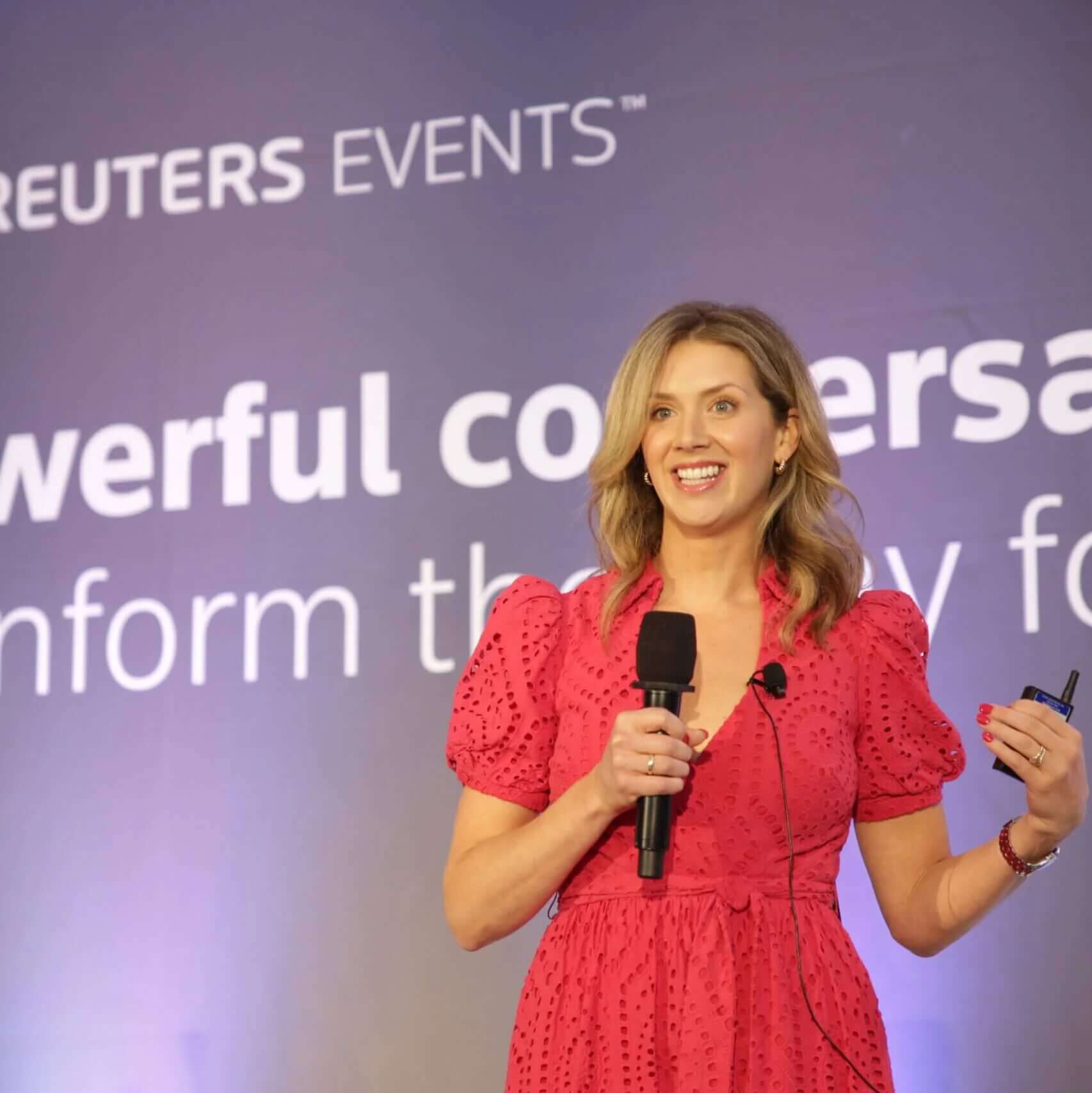
The Next Customer Connection Paradigm: Reception Marketing
May 30, 2023|Read time: 10 min.
Key Points
In early May 2023, Terakeet Chief Revenue Officer Shannon Reedy delivered the keynote presentation at the Reuters Strategic Marketing Summit. Her presentation marked a shift in the marketing and advertising landscape with the introduction of a new strategic approach to consumer connection: reception marketing. Shannon also educated marketing leaders on how to use owned asset optimization (OAO) to reach consumers throughout their ever-evolving journeys.
You can get an inside look at her presentation by reading the script or watching the video below. If you want to learn more about OAO and CMO insights, sign up for our weekly newsletter.
Terakeet has partnered with industry-leading brands for over 20 years, using a data-first approach to build customized consumer connection strategies.
Over the last year specifically, we’ve had the — I’ll call it a privilege — of solving some of the toughest challenges in consumer-to-brand connection, an evolving disconnect that we believe also reflects the current state of our industry as a whole.
This is where what we’re calling Reception Marketing, a new position on marketing, comes in.
And before I explain why we believe Reception Marketing is the next paradigm in consumer connection, and how to bring it into your own strategy, we need to first talk about and address the current state of marketing.
The Consumer Journey Has Changed
It’s no longer a linear path that predictable ends in conversion. The reality nowadays is a messy journey that cycles in and out of funnel stages. The strategies that haven’t caught up to this new journey interfere with a brand’s ability to create meaningful, helpful connections with consumers.
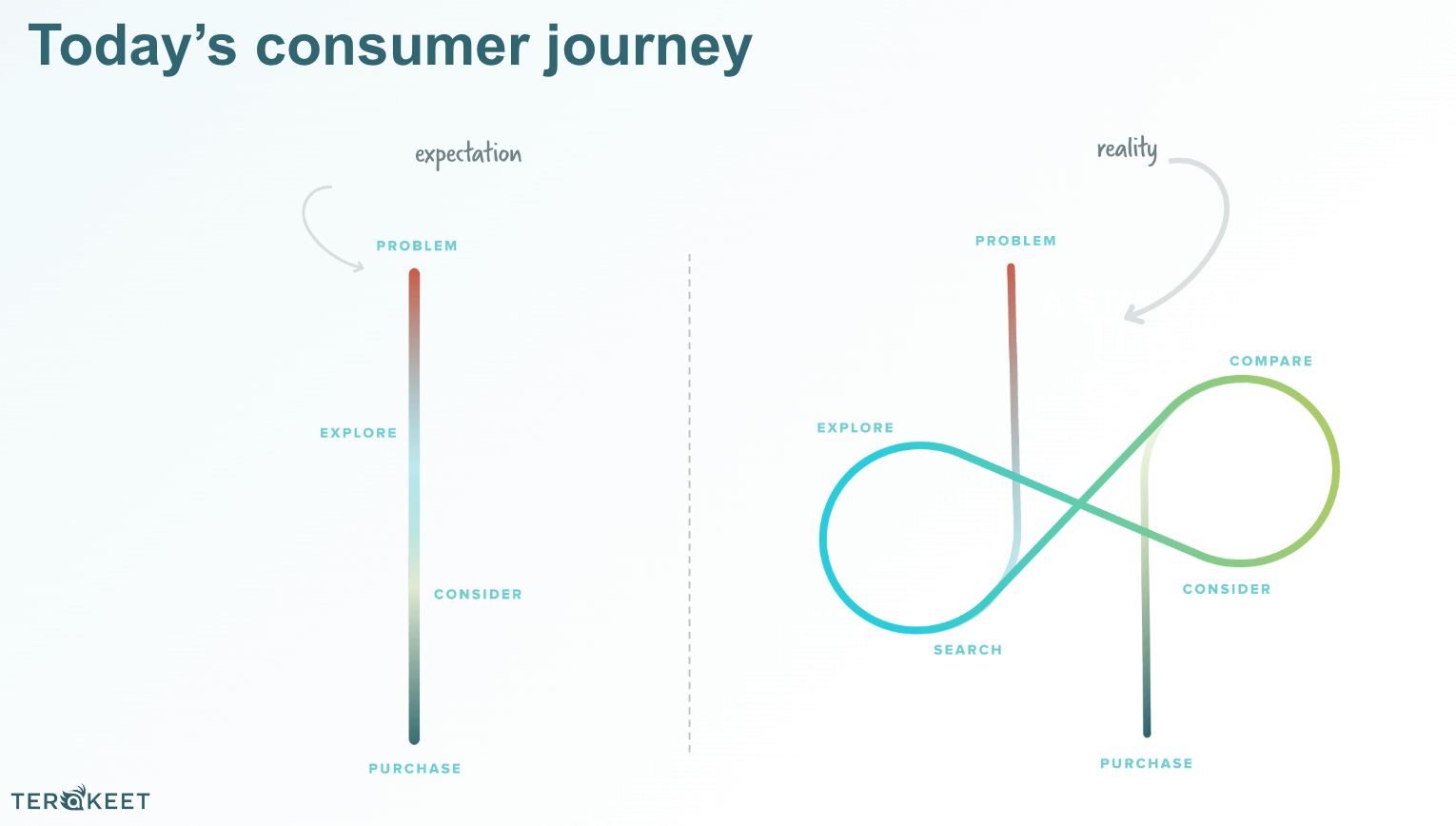
And we’ve seen the consequences of being unable to keep up and losing consumer attention.
Seemingly infallible Fortune 500 brands have crumbled because they’ve failed to adapt to changing landscapes and consumer needs. In fact, between 2000 and 2015, when this consumer shift was just starting, over half of all Fortune 500 brands disappeared.
But why haven’t they been able to keep up?
Non-traditional competitors dominate market share
We need to look at how consumer journeys are shifting. When it comes to the top and middle of the funnel, global brands are losing ground to publishers and affiliates. And it’s happening faster than you might think.
Take major beauty brands as one example. Over the last three years, they’ve lost 36% of the industry’s organic search market share to online publishers and affiliates.
These publishers have made themselves a more trusted, reliable, and engaging source when it comes to meeting consumers’ needs throughout their nonlinear journey — not just at the end in a Hail Mary attempt to get their attention for the sake of a quick transaction.
The same can be said across industries.
In home insurance, brands have lost 55% of non-branded search market share.
Pharmaceutical brands in areas like arthritis and diabetes have actually lost all non-branded search market share within their industry.
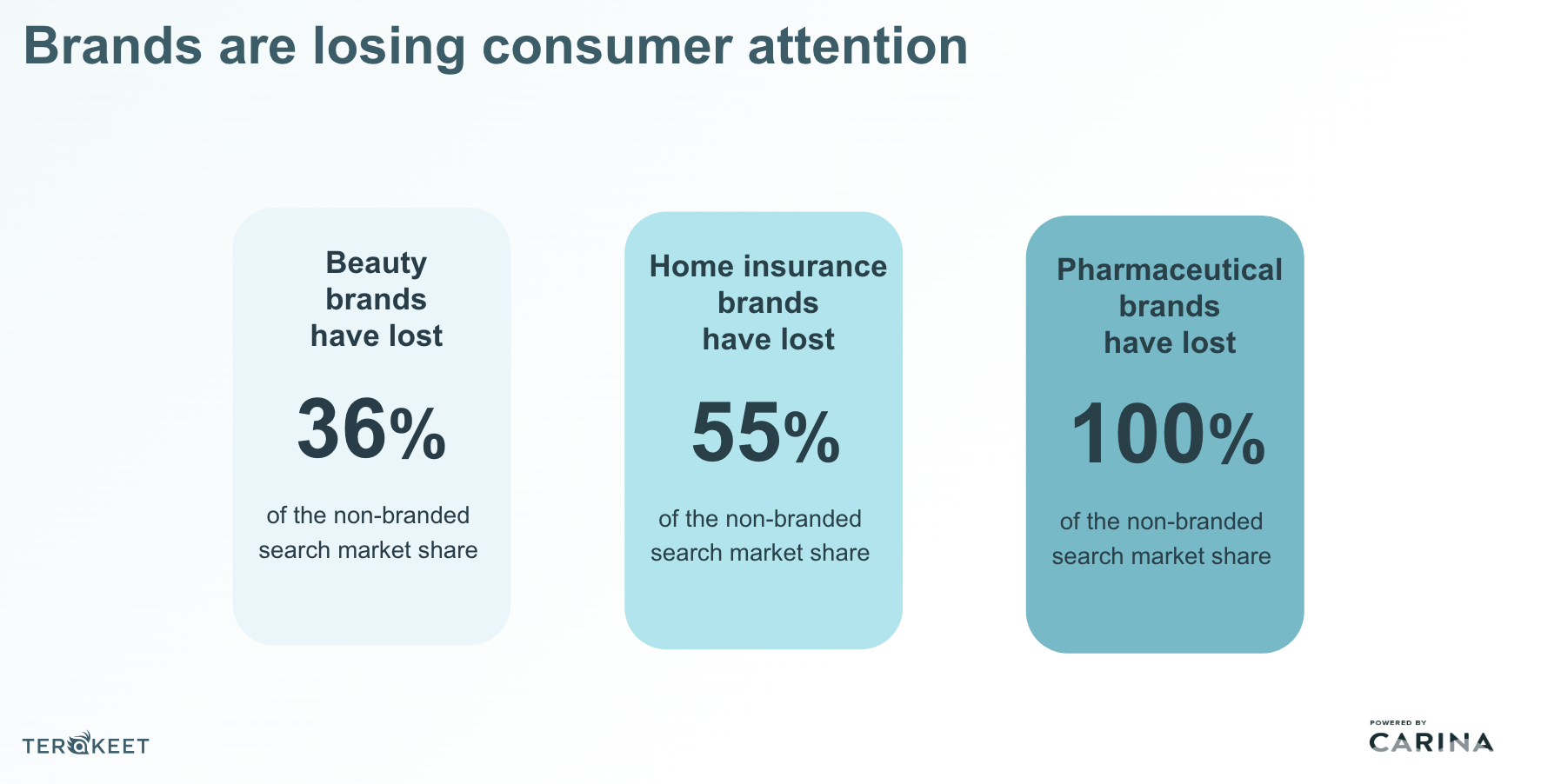
We had to ask ourselves — why is this happening?
There are two main reasons we see:
–One, as marketers, we naturally want to prioritize the things we see most directly impacting revenue. The easiest way to do that, and measure it directly, is to focus on last-touch attribution at the bottom of the funnel — using well-established channels that interrupt attention to reach people. But, this focus on selling rather than connecting fails to solve real consumer problems, let alone build meaningful relationships.
–The other reason is that consumer behavior has continued to change dramatically since the turn of the millennium, and our marketing frameworks haven’t been able to keep pace.
Let’s dive a little deeper into how our industry got here.
It’s time to stop interrupting
Ever since the first at-home advertisement in the ’20s, marketing has been a consistent presence in the American consumer’s life. Throughout the 20th century, it evolved into radio and TV commercials, then direct mail and targeted ads. These strategies sprayed buckshot messages and prayed that a few land.
And it worked for decades….But now we’re in a totally different world.
We’re all taking in 500% more information than we did just 25 years ago. Let that stat sink in for a minute.
We’ve gone from synchronous engagement with captive audiences collectively tuning into primetime TV programs to asynchronous engagement, where audiences can choose when, where, and how they consume content and interact with brands. They are less tolerant of interruption than ever before and are increasingly protective of their privacy.
Meanwhile, brands are constrained by unpredictable channels, subject to the whims of platform monopolies, middlemen, fraud, and fragmentation, that ultimately reinforce intrusive and fractured marketing tactics.
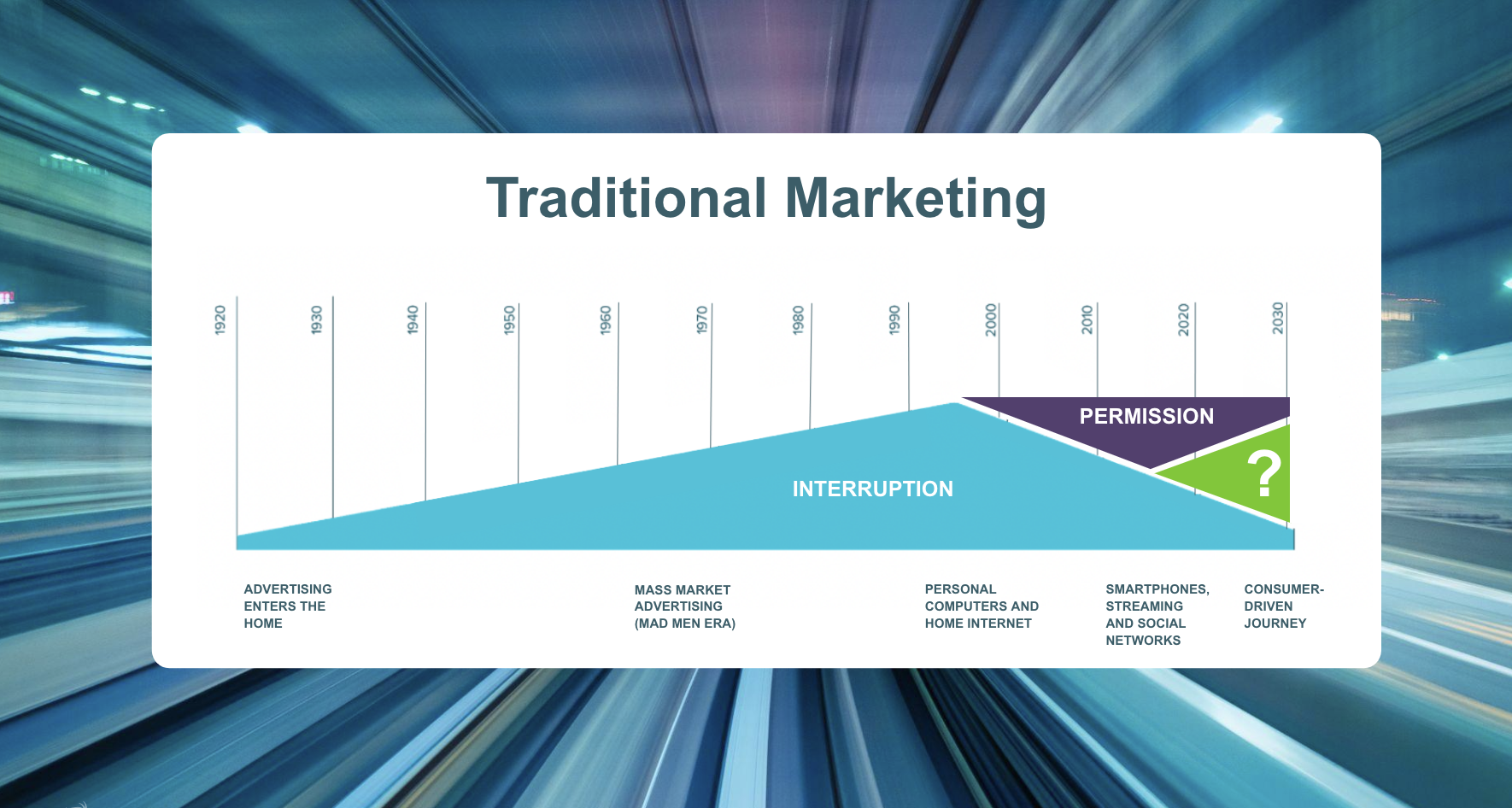
The establishment of permission marketing
In the 2000s, Seth Godin introduced permission marketing as the solution: As opposed to interruption marketing, consumers could opt-in to receive marketing messages through channels like email and social media.
But, permission marketing still interrupts a person’s day.
Just because consumers showed interest in your offering once doesn’t mean that they’re going to need your content tomorrow or a year from now. Nor does it mean the content you deliver is going to be the content they want.
If the stars align and your messages do hit an engaged customer, maybe it results in a conversion down the road. But, more often than not, these messages are not reaching the right people resulting in, at best, wasted marketing spend, and at worst, a negative brand interaction.
Permission marketing is almost always just another form of interruption, unless it’s with a consumer that you’ve already made a real connection with.
Today’s landscape requires a new approach
Today, consumers are in the driver’s seat. This means we can no longer rely only on traditional paid-first models to connect with them.
These tactics are based on transactional, fragmented, and short-term relationships that ultimately disrupt the customer journey, costing consumer attention and conversions.
So, what does meaningful connection look like with today’s consumers?
We all know brands should be working to meet consumers where they are actively looking for solutions. And isn’t this what we’re all trying to accomplish every day?
But, the challenge is: how do we make authentic connections with the empowered, active consumer?
I want everyone to ask themselves — what does my consumers’ journey look like?
Chances are, they involve Google (70% of all journeys, conservatively). And this shouldn’t be a surprise — often, this is how consumers discover your brand.
Even as marketers, ask yourselves — how often do you use to answer questions or look for information on Google every day? How often are these questions ones that are personal, or ones that you might be hesitant to ask publicly?
Tapping into The World’s Most Honest Focus Group
We see organic search as The Most Honest Focus Group that provides the most accurate consumer data, so let’s use it as a channel example.
Say you’re an insurance company selling homeowners insurance What questions do your consumers search before they’re ready to purchase your product? Like with any learning process, their questions probably cycle through all aspects of the traditional marketing funnel in a nonlinear path:
- What is homeowners insurance?
- How much is homeowners insurance?
- Types of homeowners insurance
- Best homeowners insurance
- How much does Allstate insurance cost?
You can use this search data to build more informed, more accurate consumer intent profiles because it tells you your consumers’ most burning questions.
Let’s use a real-world example.
We looked at the distribution of leads generated across the pages of one of our customers, a leading mortgage and lending company. As you might expect, a lot of that traffic converted on their main three pages.
19% converted on the next 10 pages.
But the biggest chunk of conversions came from the many smaller, niche pages specifically targeting and meeting consumer needs.
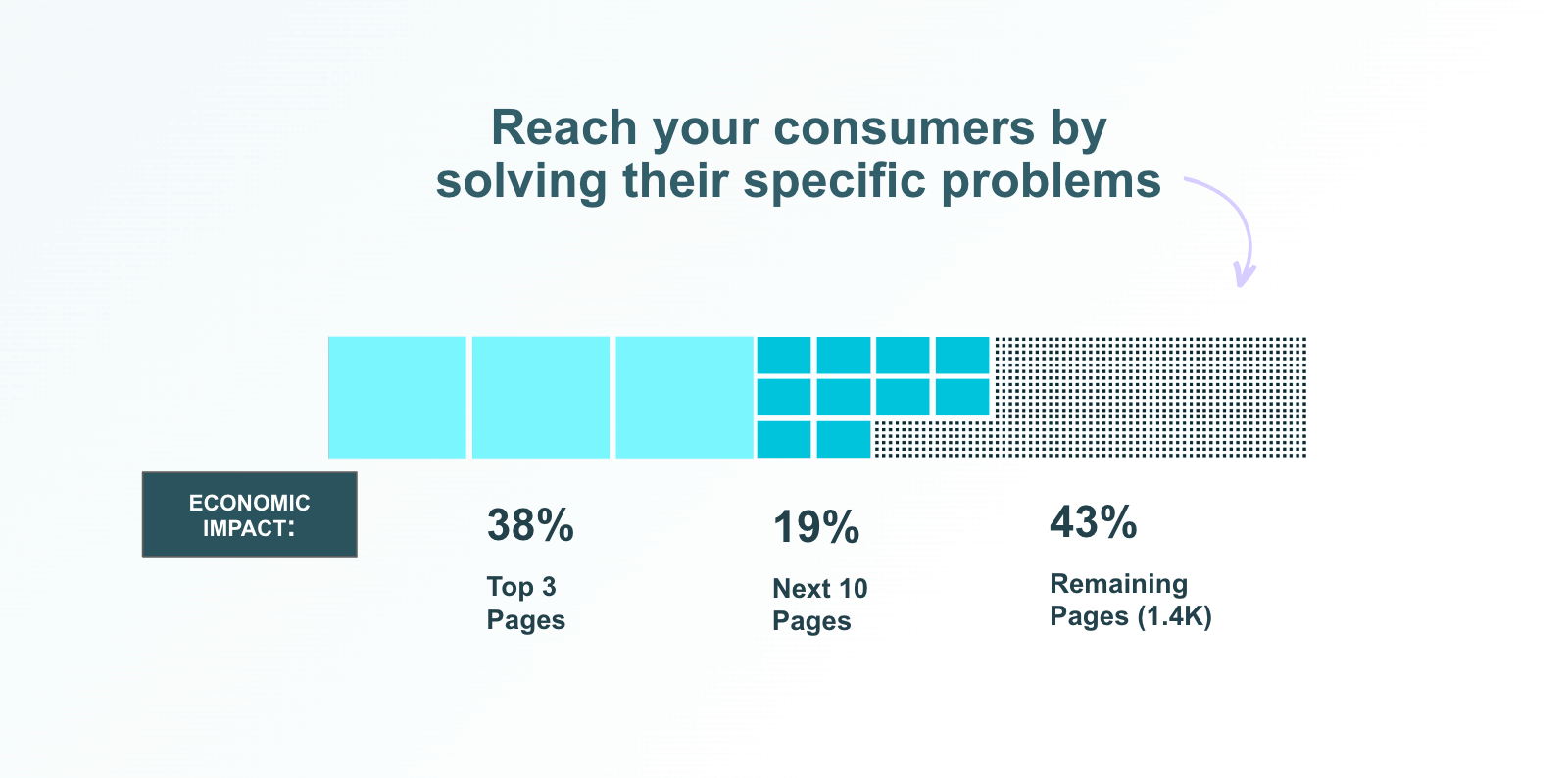
The lesson? If you only focus on the traditional strategies, you could be missing nearly half of your potential conversions.
The worst mistake we can make right now as marketers is assuming consumers are on a linear, identical journey to purchasing our product.
To reach today’s empowered consumers, we need to build a strategic foundation that allows us to be present wherever our consumer is, with a message that speaks to them at that moment.
Reception marketing is the key to consumer connection
In today’s landscape, reception marketing is the key to building long-term, meaningful connections with consumers across their fragmented journey.
Every consumer sends signals about their needs and interests throughout all points of their journey. The brands that identify those signals and respond accordingly will have their messaging most effectively received by their audience.
Reception marketing is a new approach that uncovers those cues and uses them to meet consumers where they are with the information that they need.
More effective content mapping around the customer journey helps brands ensure they provide solutions for questions that their audience is actively seeking answers about, no matter where they are.
It also doesn’t replace interruptive or permission-based strategies. Instead, it makes them stronger and more informed ways to authentically connect with consumers.
Ultimately, it delivers value for everyone — giving consumers the information they need, while positioning brands as helpful resources, increasing brand visibility, and improving customer sentiment.
Together, these add up to more conversions, more sustainable ROI, and a broader, more engaged, and more loyal customer base.
At Terakeet, we believe the best way to approach reception marketing is through a new strategy we call owned asset optimization.
Reception marketing through owned asset optimization
Owned asset optimization, or OAO, is a reception marketing strategy that prioritizes owned assets — the platforms and media you control — to tell your story, connect, and provide value to your consumers on your terms. Rather than taking a channel-first approach, like the popular PESO model, it’s asset-focused and channel agnostic.
OAO leans on consumer behavior insights to align effective messaging across a brand’s network of assets and build a strong foundation of purpose and consistency across all marketing efforts.
It relies on an organizational framework that buckets assets and channels by the degree of control brands have over the development and deployment of them.
By definition, OAO begins by first prioritizing the optimization of what you have full control over – your owned assets.
Introducing the MACH-6
Degree of Ownership/Control
Assets & Channels
Affiliates/ Influencers
Reviews
Word-of-Mouth
User-Generated Content
News
Company Profiles & Ally Websites
Organic Search
Wikipedia
Content Syndication
PR, Events, & Comms
Social Media
Bylines
Ads
Emails
Pillar Content
Blog Posts
Tools & Downloads
Corporate Communications
Website(s)
Company Values & Purpose
Brand Language & Visual ID
Proprietary Data & IP
Customer Personas
Market Positioning
Executives & Employee Ambassadors
From there, you begin to use the foundational elements to strengthen the managed category – those are assets and channels brands have some control over.
Finally, we have leveraged assets, which are areas brands can influence but have no direct control over.
Taking an asset-first approach ensures that, no matter where in the journey a user is, or what channel they’re in, they receive a controlled and optimized message, and connect with your brand.
The Brand Intelligence Report
Unique insights and analysis to supercharge your marketing strategy — direct to your inbox.
The rise of AI and OAO
Even as the industry rapidly adjusts to AI developments, this strategy remains sound because the lifeblood of AI is content. You have to publish to appear in AI results, and if that content is based on a solid brand foundation, it will tell the story you want consumers to receive.
Like with every strategy, there are several ways to approach this. At Terakeet, we harness search data — again, what we see as The Most Honest Focus Group — to understand the questions that real people are asking, and give marketers a lasting advantage.
But there are tons of sources of data you might use. The key is that the data gives you real insight to build a complete customer journey and identify the inflection points and pain points where your brand can solve a problem.
Consumer insights drive strategy
These insights should inform everything your brand creates. Then you can build a roadmap for content ideas, product enhancements, and more that can be leveraged to optimize your own owned assets.
OAO turns “traditional” marketing on its head. Instead of being channel-driven, transaction-focused, and mostly paid first, OAO turns your marketing “spend” into a business investment, helping to realize the long-term, measurable ROI of your entire digital footprint.
And it works. After adopting OAO strategies, our customers often experience their lowest CPA and up to 12x ROI.
OAO has allowed our customers to win in the new state of marketing. They’ve been able to:
- Create authentic, lasting customer relationships
- See consistent ROI on investments in content, turning it into a true performance channel
- Tell a consistent, authentic story across a complex and fragmented journey
- Build a stronger, more consistent brand presence
OAO lays the foundation for a powerful customer acquisition strategy. It’s the key to rebuilding a fractured digital experience and creating meaningful, authentic connections between consumers and your brand. And — when executed well — will supercharge all of your marketing efforts.




